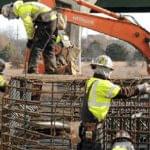Jeff Gamble is Clarkson Construction’s one-man safety show. As Loss Control Director, he is solely in charge of the safety program at the 150-year-old heavy construction company in Kansas City, Mo. He’s also in charge of safety for subsidiaries Superior Bowen, Micro-Lite, LLC, and Osage National Residential Holdings, LLC.
And at times, that can get a bit challenging.
“I don’t even have anybody I can send from jobsite to jobsite,” Gamble said. “I’d like to spend more time on jobsites, but everybody always wants something, and I’m busy putting out fires.”
Clarkson Construction and its affiliate, Superior Bowen, both recently purchased HCSS Safety to help manage safety tracking in the field. HCSS Safety allows foremen to capture safety meetings, inspections, near misses, and incidents right in the field with a smartphone or tablet and send the data directly to the office without having to fill out complicated or time-consuming paperwork by hand.
For Gamble, the ability to put safety directly into his foremen and superintendents’ hands will be a huge weight off his shoulders.
“It will allow me to be able to spend more time in the field doing what I’m supposed to be doing, instead of in the office pushing paper,” he said.
Clarkson Construction already has a solid safety program in place, with an Experience Modification Rating (EMR) of .47– well below the 1.00 national average. This means their Worker’s Compensation premium is less than half of the average for construction companies in the United States. This is important considering Clarkson Construction pays its own insurance out-of-pocket as part of a captive insurance company with 37 other contractors.
“Globally, the Clarkson companies and the Bowens have always been safety-conscious companies,” said Jim Schrader, Vice President of Total Risk Management, the company that handles all insurance claims and security for the Clarkson companies. “They’ve always asked, ‘Are we being safe out there?’ You have to be safe to be in this [insurance] group. We’re invested completely, and some years it’s a ginormous moneymaker. If you don’t have a claim, you get that money back instead of just putting it into someone’s pockets.”
Gamble said they did have an incident occur earlier this year when a dump truck driver flipped his truck. He was backed up at a dump location on an incline, and the truck fell over onto its passenger side.
The driver, who was part of a union, was not wearing his seatbelt, and spent a week in the hospital.
Gamble said during the OSHA inspection he was able to prove that the driver had been trained multiple times on wearing his seatbelt, and in the end, the company wasn’t cited because it had done its due diligence in training the driver.
“It took maybe a week to get paperwork together, and two or three days was chasing him down to get his stuff,” Gamble said. “On the safety app it would have been instant. I could have reported that incident and been done in 10 minutes, with pictures and witness statement documentation.”
For Schrader, the HCSS Safety app will put the responsibility for safety back in the workers’ hands so they understand the consequences of an incident.
“We’re trying to give them more knowledge as to what things cost,” he said. “Everyone thinks, ‘Ok, you blew your knee out. You’re out for 6 weeks.’ The reality of that is probably $80,000 that fell to the bottom line. If you don’t get a bonus this year, well that $80,000 sure as heck didn’t help.
“This puts some ownership back in the field, which needed to be done. Jeff is spread real thin – he can’t be in five places at once.”
Build a World-Class Safety Program Using HCSS Safety
-Simplify regulatory reporting by keeping all your information in one place.
-Record observations and near misses to spot trends and reduce injuries.
-Make safety effortless for foremen with pre-built toolbox talks, inspections and JHA templates.
-Create a culture of safety by making everyone accountable. Make it simple to access tools and data anytime.
